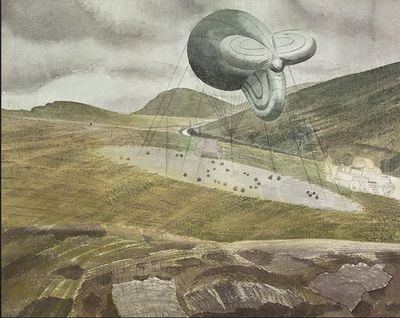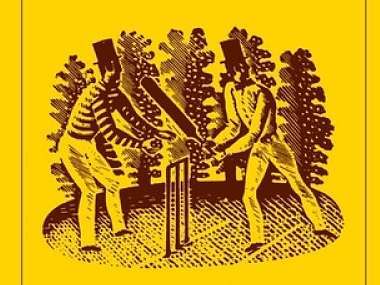Eric Ravilious in Eastbourne
"Barrage Balloons" by Eric Ravilious ��� copyright Towner gallery
By ADRIAN TAHOURDIN
Claude Debussy probably didn���t have the English Channel in mind when he wrote La Mer. He did, however, complete the piece while staying in Eastbourne���s Grand Hotel in the summer of 1905. The Grand still stands elegantly on the seafront. A few minutes��� walk away from the seafront is the Towner gallery, a modern space (all concrete and glass) dedicated to contemporary art. The Towner, together with the Jerwood Gallery in Hastings and the De La Warr Pavilion in Bexhill-on-Sea, forms a fine trio of galleries all within 25 miles of each other on the South coast. Brighton, further west up the coast and home to two universities and several art colleges, has nothing to match them.
Recording Britain, an attractive small exhibition at the Towner (until May 2, admission free), draws on work from the V&A���s collections. At the outbreak of the Second World War, Kenneth Civilisation Clark ���commissioned artists to paint ���places and buildings of characteristic national interest���, documenting rural and urban environments and precious buildings under threat, not only from bombs but from the effects of ���progress��� and development���. The project resulted in 1,500 watercolours, which went on show around the country in order to, in Clark���s words, ���inspire the war effort and boost public morale���. Forty-nine of these works are on display in Eastbourne.
The critic Michael Rothenstein wrote in World Review London in 1942: ���The zeal with which men are prepared to defend their country is sometimes inseparable from an image they carry in their own minds of the tract of countryside they hold most dear���. He may have had in mind the atmospheric watercolour by Mona Moore (1917���2000) of an ���open tract of wild countryside��� in Breckland, Norfolk (1941) or maybe the depiction of a ���Cricket Green, Great Bentley, Essex��� in 1940 by Walter Bayes (1869���1956), a founder member of the Camden Town Group. On the green a game of cricket is taking place, watched by a few leisurely spectators while, presumably, not so far away the Battle of Britain is in its early stages.
In an adjoining room is a fine display of works by Eric Ravilious (1903���42) that ���record the British landscape, in particular Sussex, at a time when the threat of war was imminent���. (An exhibition at the Dulwich Picture Gallery last year displayed more than eighty works by him.) Ravilious had been invited by Clark in 1939 to become a war artist for the War Artists Advisory Committee. The resulting work includes military aircraft and barrage balloons against the backdrop of the Sussex Downs. Towner claims to hold ���one of the largest public collections of works��� by Ravilious who disappeared in an RAF plane on a search-and-rescue operation in September 1942 off Iceland.
The 150th edition of the Wisden Cricketers��� Almanack in 2013 contained an eloquent tribute to Ravilious by his great-nephew Rupert Bates. As Bates writes, ���a batsman and a wicketkeeper ��� both nameless, both virtually faceless ��� have adorned Wisden now for 76 springs. The wood engraving of the Victorian duo in top hats is one of the sport���s most charming and recognisable images. And yet cricket knows little of its creator���. Although he claimed no talent as a cricketer, Ravilious wrote: ���It is, you might say, one of the pleasures of life, hitting a six���.
According to Bates, the Daily Telegraph called Ravilious "the greatest artistic loss Britain suffered in the Second World War���, while the Observer���s art critic Laura Cumming described him as ���the lost genius of British art���.
Peter Stothard's Blog
- Peter Stothard's profile
- 30 followers





